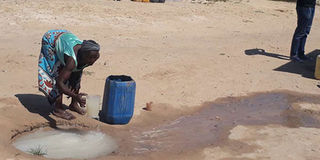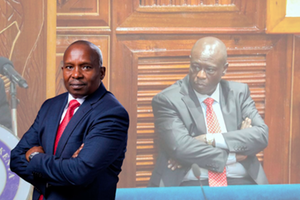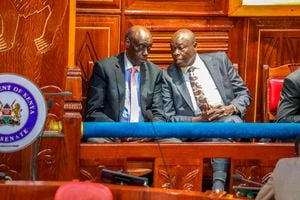Partnerships key to ending drought

A resident in Kilifi County fetches water from a puddle following drought. PHOTO | FILE | NATION MEDIA GROUP
What you need to know:
- Kenya is exploring several financing mechanisms to tackle the effects of droughts and other climate-related hazards.
- Much still needs to be done to consolidate the gains and bring us closer to achieving the overall goal of ending drought emergencies.
Droughts in Kenya are becoming increasingly regular. Kenya and the European Union (EU) stand together on the world stage as close partners in combating climate change.
The EU supports Kenya in addressing the challenges that it faces as a result of climate change, particularly in its arid and semi-arid lands (Asals).
Effects of severe periods of drought are all too evident in the millions of people affected and the substantial amounts of money in losses and damages.
The economic cost of the 2008-2011 drought in Kenya, for example, was estimated at $12.1 billion (Sh1.2tn). However, Kenya has made significant progress in managing drought risk, in which it has been strongly supported by the EU.
We attribute much of this progress to a policy shift from reactive response to an anticipatory approach that prioritises reduction of vulnerability and cushioning livelihoods through early response.
DISASTER INTERVENTION
This policy shift informed the 2011 move by Government to institutionalise drought management through a specialised institution — the National Drought Management Authority (NDMA).
The authority’s legal basis was further strengthened by the NDMA Act, 2016. Among our collective progress so far is the formulation of the Ending Drought Emergencies (EDE), an over-arching policy and strategic framework for drought risk management, which all the main parties have endorsed and are supporting.
Thanks to the EU's financial support, the drought early warning system has undergone significant modernisation such as adoption of mobile phone technology to improve data collection and integration of satellite data.
Consequently, the drought response interventions carried out in 2016-17 by various stakeholders were much more timely and effective than those implemented during the drought of 2008-11.
EU FUNDING
Kenya is exploring several financing mechanisms to tackle the effects of droughts and other climate-related hazards.
To this end, the NDMA Act established a National Drought Emergency Fund to ensure resources will always be available for quick action before a drought deteriorates.
Regulations for operationalisation of the fund are now awaiting approval by the National Assembly.
In the meantime, the NDMA has been testing and refining use of drought contingency finances with approximately Sh3.7 billion funding from the EU.
This enabled the NDMA to respond promptly to the first signs of drought in August 2016: For example, the specially constituted livestock feed supplements distributed in several counties in 2016-17 significantly reduced livestock mortality.
Much still needs to be done to consolidate the gains and bring us closer to achieving the overall goal of ending drought emergencies.
Of utmost importance is to fast-track support for the “foundational” pillars of Vision 2030 such as security, infrastructure, education, health and nutrition.
Mr Pozzi is Acting Head of the EU Delegation to Kenya while Mr Oduor is the CEO of the National Drought Management Authority.




